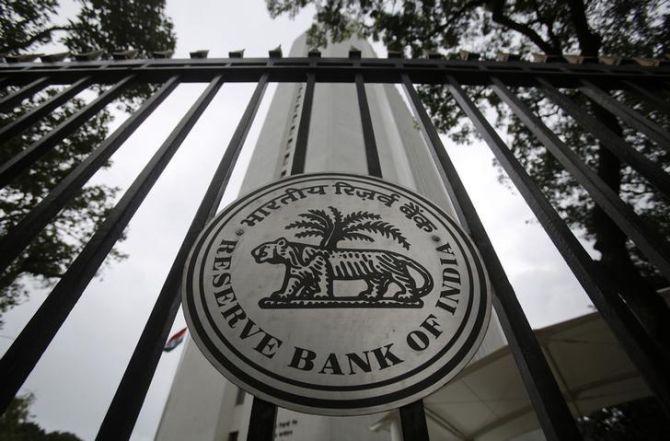 | « Back to article | Print this article |
An NBFC must actively manage its collateral positions, differentiating between encumbered and unencumbered assets, and monitor such assets so that they can be mobilised in a timely manner, central bank says in circular.

The Reserve Bank of India on Friday said from April 1 next year, large non-banking financial companies should maintain a liquidity coverage ratio (LCR) in line with banks and carry enough collateral that can be used for liquidity needs.
Even as the draft offered no hint of a possible liquidity window for the troubled NBFC sector, the central bank said it remained “committed to promote a robust, vibrant and well-functioning NBFC sector”.
“An NBFC should have sufficient collateral to meet expected and unexpected borrowing needs and potential increases in margin requirements over different timeframes,” the RBI said in a draft circular, in which it asked the firms to have enough high-quality assets that would keep them liquid for at least 30 days.
An NBFC must actively manage its collateral positions, differentiating between encumbered and unencumbered assets, and monitor such assets so that they can be mobilised in a timely manner.
All NBFCs must have contingency funding plans for responding to severe disruptions and liquidity positions should be disclosed to the public for investors.
Although the liquidity rules were proposed for all NBFCs, for NBFCs with assets above Rs 5,000 crore and deposit-taking NBFCs, the LCR was mandatory.
Recently, the RBI asked large NBFCs to introduce chief risk officers to manage asset-liability mismatches on the books. The LCR “will promote resilience of NBFCs to potential liquidity disruptions by ensuring that they have sufficient High Quality Liquid Asset (HQLA) to survive any acute liquidity stress scenario lasting for 30 days”, the central bank said in its draft guidelines.
HQLAs are generally cash or government securities that can be quickly sold in the market to raise cash.
The RBI said by April 1, 2024, large and deposit-taking NBFCs should have HQLAs of a minimum of 100 per cent of net cash outflows over the next 30 calendar days.
“The LCR requirement shall be binding on NBFCs from April 01, 2020, with the minimum HQLAs to be held being 60% of the LCR, progressively increasing in equal steps reaching up to the required level of 100% by April 01, 2024,” said the draft guidelines.
In its draft rules, the RBI proposed sweeping changes in how liquidity was managed in all NBFCs.
All non-deposit-taking NBFCs with an asset size of Rs 100 crore and above, systemically important core investment companies and deposit-taking NBFCs irrespective of their asset size were told to measure their liquidity in a granular manner, measuring as minutely as one to seven days’, 8-14 days’, and 15-30 days’ buckets. Asset-liability mismatches should not exceed 10-20 per cent in the buckets running up to a year, the draft said. This has to be reported to the RBI, along with the interest rate sensitivity statement.
The RBI said in addition to structural and dynamic liquidity needs, a stock approach will also have to be maintained to gauge liquidity needs. NBFCs were asked to maintain tools that would generate early warning for concentration, counterparty, instrument, currency risks etc.
Keki Mistry, the vice-chairman and chief executive officer, HDFC, said: “Since the IL&FS crisis, there has been nervousness in the market. Over the past few months, many NBFCs have not been able to borrow from markets, including banks. With the RBI bringing in these guidelines to manage asset-liability mismatches, lenders will get more confidence.”
Gagan Banga, managing director, Indiabulls Housing Finance Ltd, said: “The regulations are extremely good and the sector needs to be regulated well. The sector can thrive if the perception is that it is well regulated.”
“All the highly rated NBFCs are already ahead of the RBI norms. The good NBFCs have more than 60 per cent of liquidity coverage ratio and maintains more than 30 days’ liquidity. We at Indiabulls are at 120 per cent and one year of liquidity compliant,” Banga said. IIFL Chairman Nirmal Jain said most NBFCs maintained a good amount of liquidity as a board-driven policy.
“The regulatory norms are good for the long-term sustainability of the sector,” Jain said. According to Jain, temporary liquidity needs should not be equated with the long-term health of the sector and so the RBI’s efforts to regulate the sector more should be welcomed by all.
The RBI wanted to know details about off-balance sheet and contingent liabilities, stress testing, intra-group fund transfers, diversification of funding, collateral position management, and contingency funding plan of NBFCs. Comments on the draft can be emailed to the RBI till June 14.
Photograph: Vivek Prakash/Reuters.